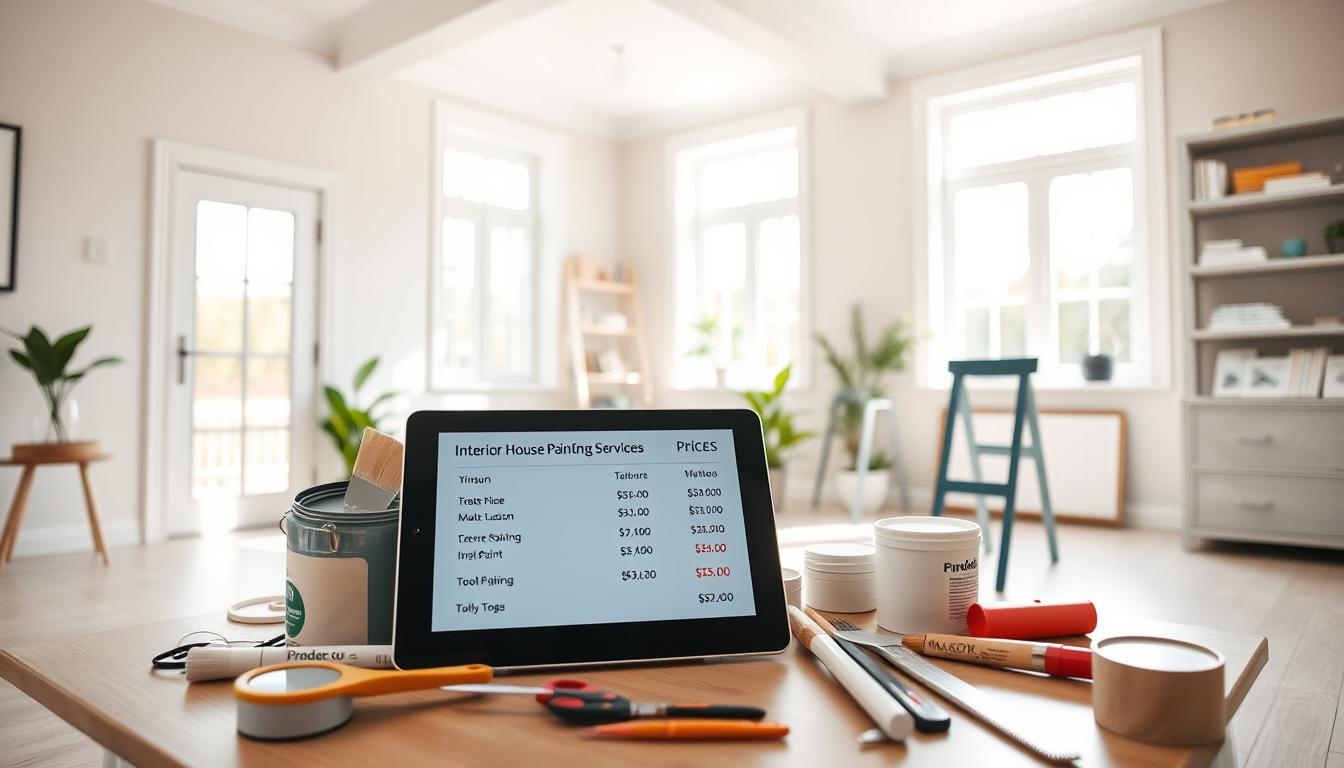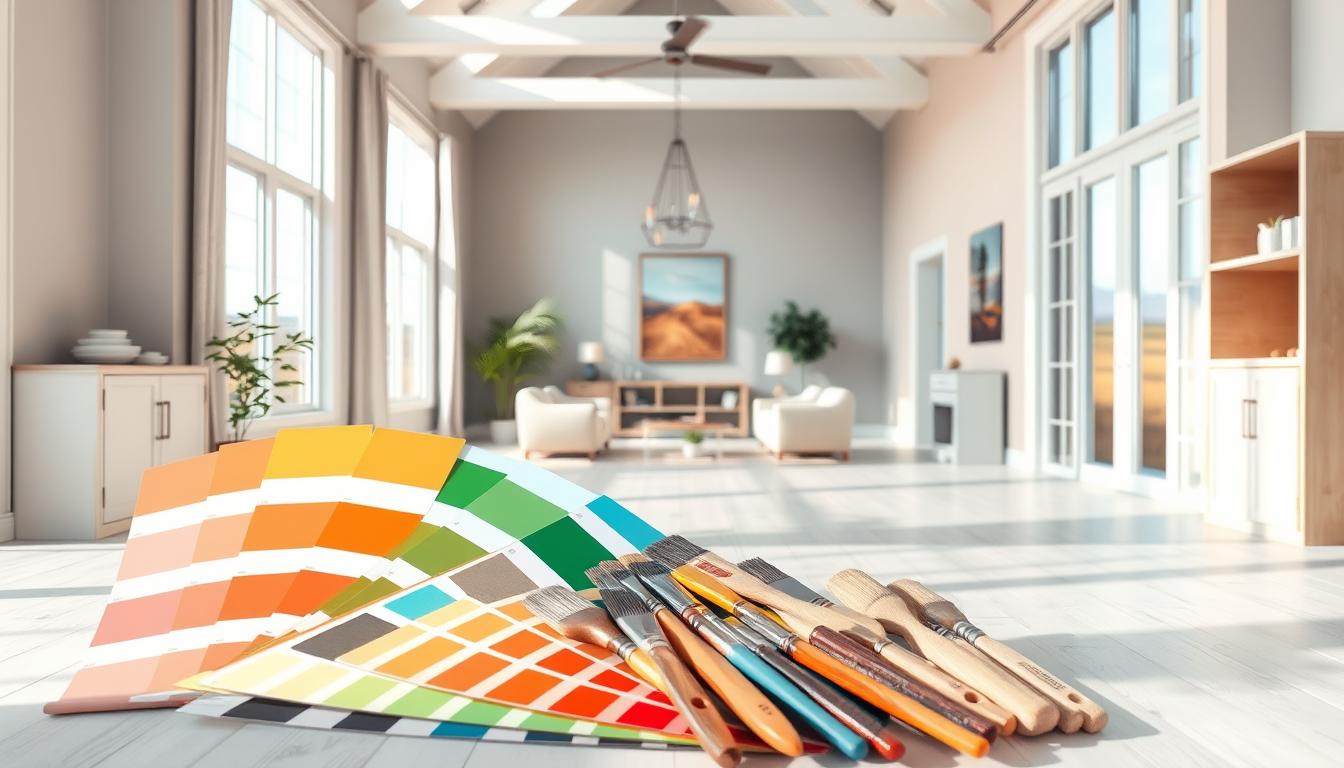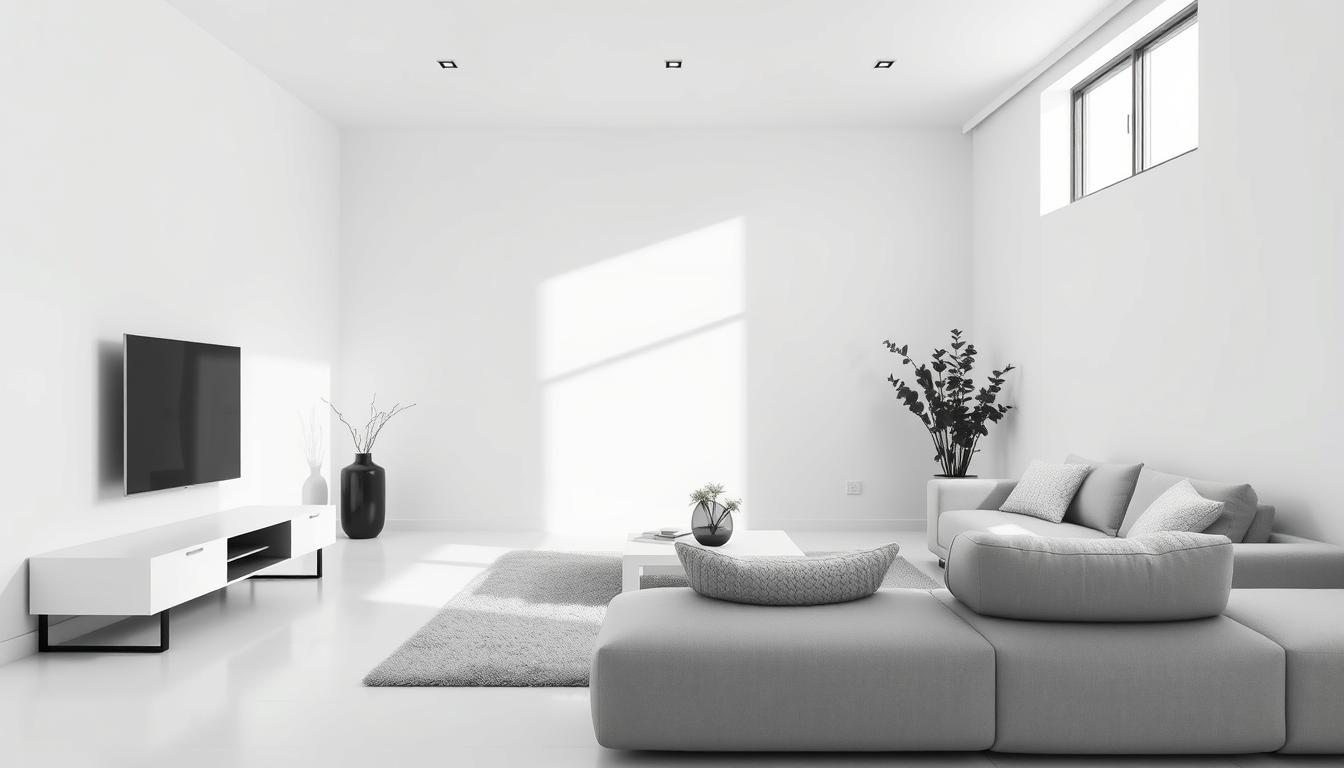Did you know painting the inside of a home costs about $2.75 per square foot? This can greatly affect your budget for renovations or updates. It’s important to know what affects interior house painting prices to make smart choices.
Adding walls, trim, and ceilings can raise the cost to $4.69 per square foot. This guide will explain the key factors that influence professional interior painting cost. It aims to help you plan and budget your painting project well.
Key Takeaways
- Average cost to paint the interior of a home is $2.75 per square foot.
- Including walls, trim, and ceilings, the cost increases to $4.69 per square foot.
- Understanding the factors that affect interior painting costs is essential for budgeting.
- A comprehensive guide helps homeowners make informed decisions about their painting projects.
- Professional interior painting cost varies based on several factors, including surface area and complexity.
Understanding the Factors Affecting Painting Costs
Knowing what affects interior painting costs is key for homeowners. When you plan to paint your walls, several factors can change the cost a lot.
Room Size and Layout
The room’s size is a big factor in painting costs. Bigger rooms need more paint, equipment, and work, raising the price. For example, a big living room with high ceilings costs more than a small bedroom.
The room’s layout, including windows, doors, and special features, also matters. It helps figure out the final cost.
Paint Quality and Type
The paint’s quality and type can really change the cost. High-end paints with special features cost more than regular ones. The finish, like flat or glossy, also affects the price.
For more details on how paint quality and type impact costs, check out this guide.
Labor Costs and Local Rates
Labor costs are a big part of the painting estimate. Rates vary by location, with cities often being pricier than rural areas. The job’s complexity, like fixing holes or sanding, also raises costs.
More experienced painters might charge more but offer better work. This extra cost might be worth it for quality.
Average Costs for Interior Painting
When planning an interior painting project, knowing the average costs is key. This helps homeowners budget and make smart choices.
National Averages
The national average for interior painting is $2 to $5 per square foot. For example, a small room, about 120 square feet, might cost $240 to $600. These prices include labor and paint costs nationwide.
Price per Square Foot
The cost per square foot is a big factor in your painting project’s total cost. It can range from $2 to $5, depending on the job’s complexity and paint quality. For example:
- A simple job with standard paint might cost about $2 per square foot.
- A more complex job with better paint or extra prep could cost $3 to $5 per square foot.
Cost Variations by Region
Interior painting costs also vary by region. This is due to labor costs, living costs, and local rules. For instance:
- Urban areas often have higher labor costs than rural areas, affecting prices.
- Places with a higher cost of living may also have higher painting prices.
To get a precise estimate, talk to local painting contractors. They can give you a quote based on your project and location.
An interior painting cost calculator can also help estimate costs. Online tools let you input your project details for a more accurate estimate. When looking for best interior house painters or affordable home painting services, check reviews and compare quotes to find the best deal.
DIY vs. Professional Services
Choosing between DIY interior painting and hiring pros is key. It affects the quality and your wallet. It’s important to know the good and bad of each choice.
Benefits of Hiring Professionals
Professionals bring many benefits to your painting job. Expertise and Efficiency are big pluses. They do the job fast and well.
- High-quality finish
- Time-saving
- Access to professional-grade equipment
A pro painter said, “Hiring a pro can change your home’s look and feel. It’s worth it for the quality and peace of mind.”
“The right paint can completely transform a room, but achieving a professional finish requires more than just paint; it demands skill and experience.”
Cost Implications of DIY
DIY can save money since you don’t pay for labor. But, think about the cost of materials and tools and your time.
| Cost Component | DIY Cost | Professional Cost |
|---|---|---|
| Paint | $200-$500 | Included in total cost |
| Labor | $0 (your time) | $1,000-$3,000 |
| Tools and Equipment | $50-$200 | Included in total cost |
Tools and Materials Needed for DIY
If you choose DIY, you’ll need the right stuff. Essential items are quality paint, brushes, rollers, and drop cloths.
Knowing the costs, benefits, and needs of DIY and pro services helps you choose wisely. It’s about what fits your needs and budget.
Additional Costs to Consider
When planning to paint your house’s interior, remember there are costs beyond the paint. These can greatly affect your budget. It’s important not to overlook them.
Surface Preparation
Surface preparation is key and can increase your costs. This includes cleaning walls, fixing holes, and sanding rough spots. Good surface prep leads to a smooth finish and paint that lasts longer. The cost depends on your walls’ condition and the materials needed.
If your walls have old paint or are damaged, you might need special tools or professional help. Surface prep can add $0.50 to $2 per square foot to your total cost.
Repairs and Patching
Repairs and patching are big costs. Walls with holes, cracks, or damage need fixing before painting. The cost varies based on the damage. Check your walls well before painting to find any repairs needed.
Experts say, “Good prep is key for a great paint job. Skipping repairs can ruin the finish and shorten the paint’s life.”
“A well-prepared surface is the foundation of a great paint job.”
Primer and Finishing Costs
Primer and finishing costs are also important. Primer helps paint stick better, which is crucial for new or stained surfaces. Primer adds to your cost but ensures a professional look.
Finishing costs, like trim and ceiling work, also matter. These tasks need extra materials and labor, adding to the total cost. Make sure to include these costs in your budget to avoid surprises.
- Think about the color and finish you want, as they can change paint and primer costs.
- Remember to include repair and prep costs.
- Decide if you’ll do it yourself or hire pros, weighing the costs and benefits.
Choosing the Right Paint
It’s important to know the different types of paint and their qualities for a good painting job. The paint you choose affects the cost, how long it lasts, and how it looks.
Types of Interior Paint
There are many types of interior paint, each with its own benefits. The most common ones are:
- Latex paint: Water-based and versatile, ideal for most interior surfaces.
- Oil-based paint: Known for its durability and smooth finish, often used for trim work.
- Acrylic paint: Offers a balance between latex and oil-based paints, providing durability and ease of use.
When picking a paint, think about the surface, the finish you want, and any special needs like eco-friendliness or resistance to mold and mildew.
Eco-Friendly Options
If you care about the environment, there are eco-friendly paint options. These paints use natural ingredients, have low VOCs, and are biodegradable. Some well-known eco-friendly paint brands are:
- Benjamin Moore’s Natura line
- Behr’s Premium Plus U270 series
- Sherman Williams’ Harmony line
Choosing eco-friendly paints helps the planet and makes your home air cleaner.
Finish Options and Their Costs
The paint finish greatly affects how it looks and lasts. Common finishes are:
- Flat (Matte) Finish: Ideal for low-traffic areas and ceilings.
- Eggshell Finish: Offers a slight sheen, suitable for living areas.
- Satin Finish: Provides a soft glow, often used in high-traffic areas.
- Gloss Finish: Highly reflective and durable, typically used for trim and doors.
Higher gloss paints are more durable but can show surface flaws. The cost varies by finish, with gloss paints often being pricier.
By thinking about these factors and options, homeowners can choose the best paint for their projects. This ensures a beautiful and lasting finish.
Estimating Your Painting Project
Before you start painting, it’s key to figure out the costs. This way, you won’t be surprised later. A good estimate helps you budget and makes the project go smoothly.
Measuring Your Space
First, measure your space to get an accurate estimate. You need to know the area of walls, ceilings, and trim. Also, remember to exclude areas like windows and doors.
For simple rooms, a tape measure works fine. But for complex or big projects, a laser tool or a pro’s help might be better.
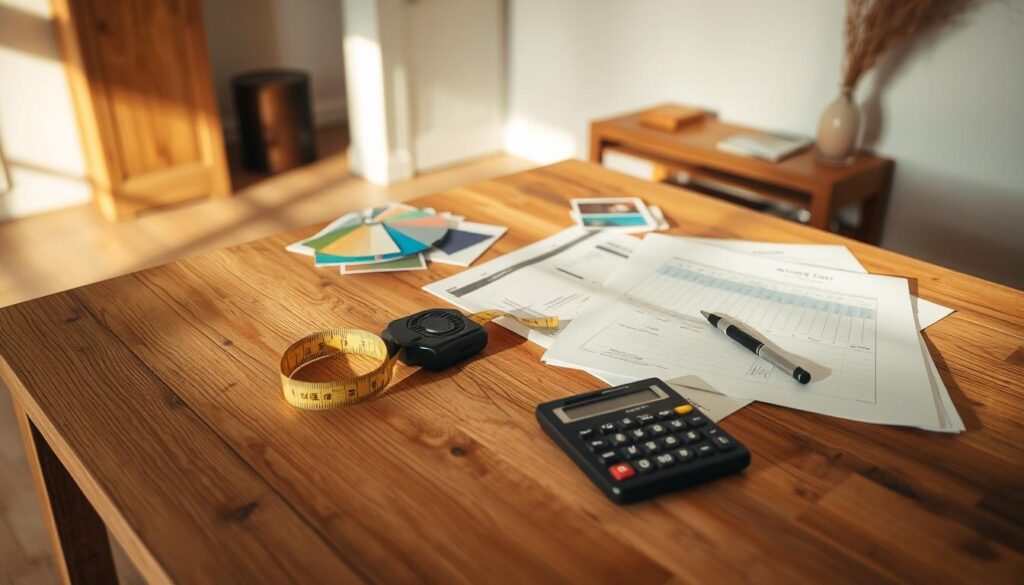
Calculating Paint Needed
After measuring, figure out how much paint you’ll need. Paint cans usually tell you how much area one gallon covers. About 350-400 square feet per gallon is typical. Divide your total area by this to find out paint needs.
Remember, surface texture and porosity can change paint needs. Rough or porous surfaces might need more paint or primer.
Creating a Budget
Now, plan your budget based on paint and other materials. Don’t forget about brushes, rollers, and possibly primer. If hiring a pro, add labor costs, which vary by location and job complexity.
Get quotes from different contractors to compare. Also, think about extra costs like repairs or surface prep.
By following these steps, you can make a detailed estimate. This ensures you’re ready for the project’s costs.
Planning Your Interior Painting Project
Effective planning is key to a successful interior painting project. It helps avoid unexpected costs and ensures the final result meets your expectations.
Timing the Project
Timing is crucial for interior painting. Weather conditions can impact drying times and paint quality. For interior projects, focus on scheduling around your daily routine and keeping disruptions low.
- Plan around your daily activities to minimize disruptions.
- Consider the time of year and how it might affect your interior environment (e.g., humidity levels).
- Book your project well in advance to secure a spot with professional painters.
Choosing Colors and Styles
Selecting the right colors and styles is vital. Consider the mood and ambiance you want to create in your space.
- Start by choosing a color scheme that complements your furniture and decor.
- Test paint samples on your walls before making a final decision.
- Consider consulting with a professional for advice on color selection and finishes.
Hiring the Right Contractor
Finding the right contractor is crucial for project success. Look for contractors with experience in interior painting and good reviews.
- Get multiple quotes to compare prices and services.
- Check for licenses, insurance, and certifications.
- Ask for references and check their portfolio for previous work.
By planning carefully, including timing, color selection, and hiring the right professionals, you can achieve a beautiful result. This will enhance your home’s value and appeal.
Maintenance and Longevity of Interior Paint
To keep your interior paint looking good, you need to take care of it. Taking care of your paint makes your home look better and saves you money. It means you won’t have to repaint as often.
Caring for Your Painted Surfaces
Keeping your painted surfaces clean is key. Use a soft cloth and mild soap for cleaning. This helps keep the paint looking nice. Also, clean up spills right away to avoid damage.
- Dust regularly to prevent buildup
- Avoid using abrasive cleaners that can damage the paint
- Use a damp cloth for cleaning to prevent streaks
Estimated Lifespan of Different Paints
The life of interior paint depends on the paint quality and where it’s used. High-quality paints can last 5 to 10 years or more in quiet areas. But, cheaper paints might need a new coat every 2 to 5 years.
For more details on paint longevity, see our article on how long interior paint lasts.
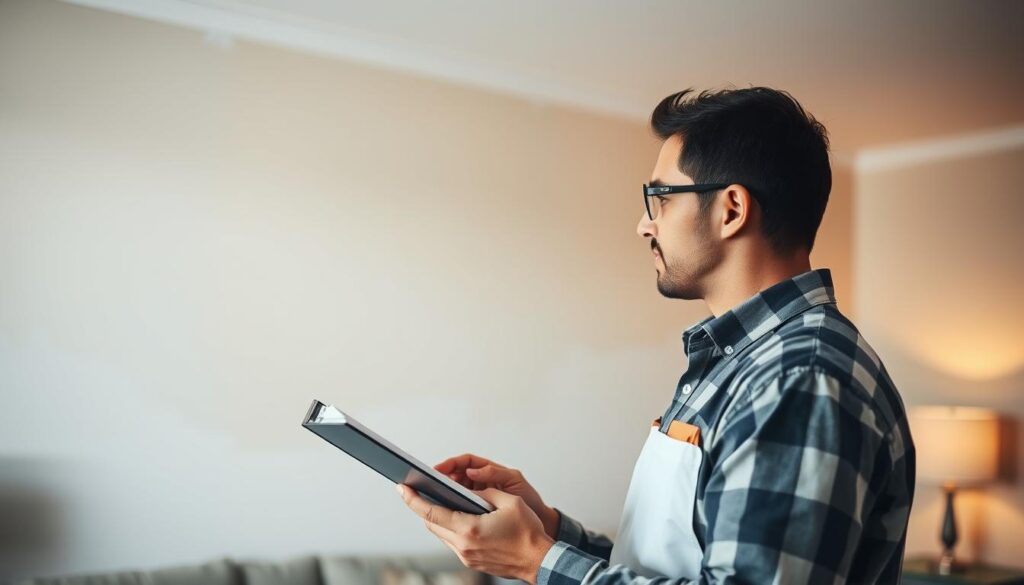
Signs It’s Time for a New Coat
It can be hard to know when to repaint. Look for fading, chipping, or cracking paint. Also, if the paint looks dull or has stains that won’t go away, it’s time for a new coat.
- Visible wear and tear on the paint surface
- Dullness or loss of sheen
- Stains or discoloration that are difficult to clean
Final Thoughts on Interior Painting Costs
Knowing the costs of interior painting is key for homeowners wanting to update their homes. We’ve looked at many factors that affect these costs. These include room size, paint quality, labor, and local rates.
Key Considerations for Homeowners
When planning to paint your home’s interior, think about the total cost. This includes prep work, repairs, and finishing touches. An interior painting cost calculator can give you a good estimate for your project.
Budgeting for Your Project
To plan your budget, consider hiring pros if you’re new to painting. Professional interior painting costs vary but can be worth it for a top-notch finish. If you’re painting yourself, remember to include the cost of tools and materials.
Additional Resources
For more details on painting costs, check out online resources or talk to local painters. They can offer advice on painting your home’s interior. They can also help you set a budget that fits your needs.
FAQ
How much does it cost to paint the interior of a home?
What factors affect the cost of interior painting?
Is it cheaper to paint a room myself or hire a professional?
How do I estimate the cost of painting a room?
What is the average cost to paint a room?
FAQ
How much does it cost to paint the interior of a home?
The cost to paint a home’s interior varies. It depends on room size, paint quality, and labor costs. On average, homeowners pay between and per square foot.
What factors affect the cost of interior painting?
Several factors influence interior painting costs. These include room size, paint quality, labor costs, and local rates. Knowing these can help estimate painting costs.
Is it cheaper to paint a room myself or hire a professional?
DIY painting can save money, but hiring a pro ensures quality and saves time. DIY costs add up with tools and materials.
How do I estimate the cost of painting a room?
To estimate costs, measure the room, calculate paint needs, and consider labor and materials. Don’t forget any repairs or prep work.
What is the average cost to paint a room?
Room painting costs vary by size and location. National averages are 0 to
FAQ
How much does it cost to paint the interior of a home?
The cost to paint a home’s interior varies. It depends on room size, paint quality, and labor costs. On average, homeowners pay between $2 and $6 per square foot.
What factors affect the cost of interior painting?
Several factors influence interior painting costs. These include room size, paint quality, labor costs, and local rates. Knowing these can help estimate painting costs.
Is it cheaper to paint a room myself or hire a professional?
DIY painting can save money, but hiring a pro ensures quality and saves time. DIY costs add up with tools and materials.
How do I estimate the cost of painting a room?
To estimate costs, measure the room, calculate paint needs, and consider labor and materials. Don’t forget any repairs or prep work.
What is the average cost to paint a room?
Room painting costs vary by size and location. National averages are $300 to $1,000 per room, with regional differences.
How do I choose the right paint for my interior painting project?
Choose paint based on type, eco-friendliness, and finish. Different paints cost differently. Understanding these options helps make a good choice.
What additional costs should I consider when budgeting for my painting project?
Consider surface prep, repairs, primer, and finishing costs. These can quickly add up, so include them in your budget.
How can I maintain and extend the life of my interior paint?
To keep paint looking good, clean surfaces regularly and avoid harsh chemicals. Touch up scratches and marks to maintain the paint.
How long does interior paint typically last?
Paint lifespan varies by type and conditions. On average, it lasts 5 to 10 years, with high-quality paint lasting longer.
What are the signs that it’s time for a new coat of paint?
Look for fading, chipping, cracking, and staining. If you see these, it’s time for a new coat of paint.
,000 per room, with regional differences.
How do I choose the right paint for my interior painting project?
Choose paint based on type, eco-friendliness, and finish. Different paints cost differently. Understanding these options helps make a good choice.
What additional costs should I consider when budgeting for my painting project?
Consider surface prep, repairs, primer, and finishing costs. These can quickly add up, so include them in your budget.
How can I maintain and extend the life of my interior paint?
To keep paint looking good, clean surfaces regularly and avoid harsh chemicals. Touch up scratches and marks to maintain the paint.
How long does interior paint typically last?
Paint lifespan varies by type and conditions. On average, it lasts 5 to 10 years, with high-quality paint lasting longer.
What are the signs that it’s time for a new coat of paint?
Look for fading, chipping, cracking, and staining. If you see these, it’s time for a new coat of paint.

